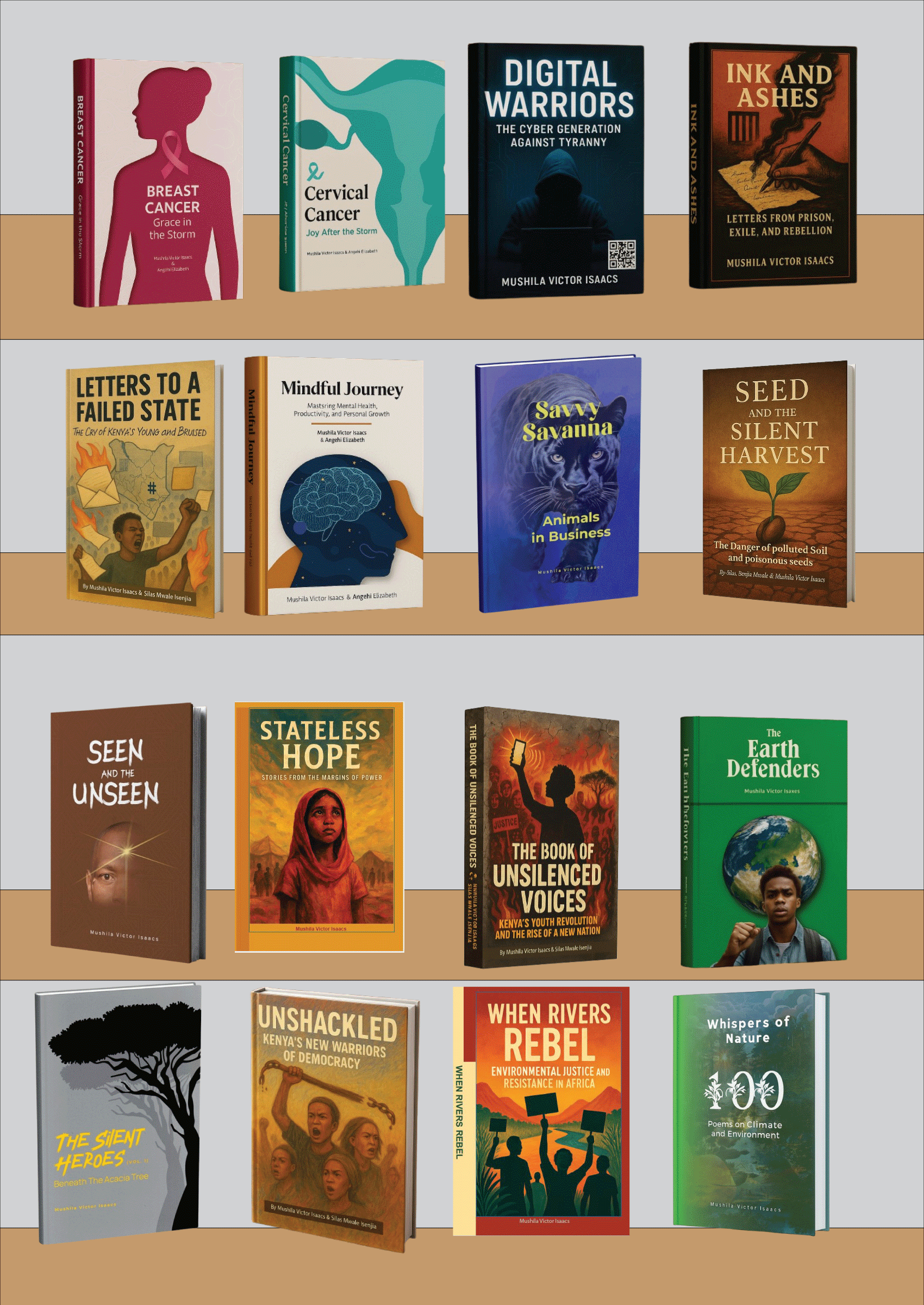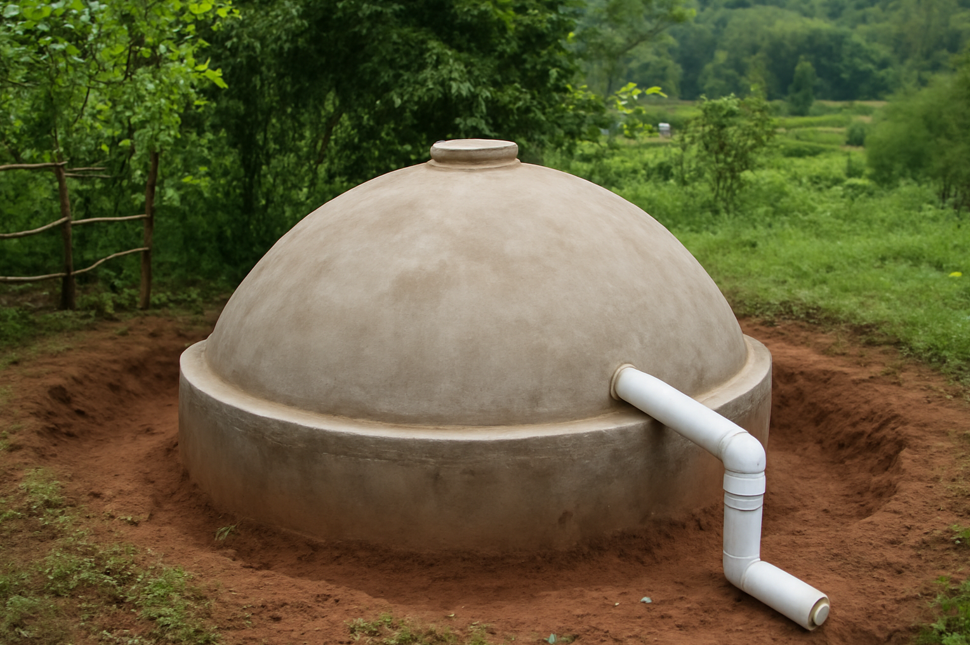Biogas for Brighter Futures
Clean Energy and Digital Access in Kakamega County
Introduction
In a world increasingly affected by climate change and digital inequality, MushilaWrites introduces an innovative solution: the Biogas-Powered Electricity Prototype for schools in Kakamega County. This system will power 30 LED bulbs and 15 computers, turning organic waste into opportunity.
This initiative reflects Mushila Victor Isaac’s mission, whose literary works—particularly his books titled The Earth Defenders and Whispers of Nature: 100 Poems on Climate and Environment—inspire action for clean green energy and a more sustainable world.
Vision, Mission, and Objectives
Vision: Sustainable energy hubs that empower youth and promote digital inclusion.
Mission: Use biogas technology to drive clean energy and climate education.
Objectives:
- Convert organic waste into biogas for electricity and cooking.
- Power 30 LED bulbs and 15 computers daily.
- Integrate climate literacy into school life.
- Showcase a replicable green energy model.
- Connect environmental action with storytelling.
Why Kakamega?
Kakamega County is more than a location—it’s a living story of resilience, biodiversity, and untapped potential. Nestled in western Kenya, this region pulses with ecological wonder and cultural pride. With a population density of approximately 627 people per square kilometer, Kakamega is one of Kenya’s most densely populated counties, reflecting both its fertile land and the vibrancy of its communities.
Location and Borders
Positioned just north of the equator, Kakamega is bordered by:
- Bungoma to the north
- Vihiga to the south
- Nandi to the east
- Busia to the west
Its location it a natural bridge between Kenya’s Rift Valley and Western regions—a crossroads of trade, agriculture, and cultural exchange.
Economic Activities
Agriculture is the heartbeat of Kakamega:
- Maize, sugarcane, beans, and vegetables dominate the landscape
- Tea plantations flourish in Shinyalu’s highlands
- Dairy farming and poultry supplement household incomes
- Boda boda transport, informal trade, and small-scale manufacturing fuel local enterprise
Physical Features and Natural Beauty
- Kakamega Forest: Kenya’s only tropical rainforest, home to rare species like the De Brazza monkey, giant forest hogs, over 300 bird species, and butterflies. A sanctuary for biodiversity and climate education.
- Shinyalu Hills: Rolling, fertile, and scenic—perfect for biogas feedstock generation and nature-based learning.
- Rondo Retreat Center: A tranquil haven within the forest, ideal for spiritual reflection, ecological immersion, and literary inspiration.
Social and Cultural Lifestyle
- Bullfighting: A revered Luhya tradition symbolizing strength, community, and ancestral pride
- Crying Stone of Ilesi: A mystical rock formation that “weeps” during the rainy season, echoing local legends and spiritual reverence
- Ugali: More than a staple—it’s a cultural anchor, representing unity, resilience, and shared identity
These traditions offer fertile ground for storytelling, environmental education, and community engagement.
Women Empowerment and Child Support
- Women-led cooperatives in farming, clean energy, and microfinance
- Girls’ education and digital literacy programs gaining momentum
- Maternal health and child nutrition initiatives expanding in rural areas
The Biogas for Brighter Futures initiative complements these efforts by:
- Reducing the burden of firewood collection
- Creating safe, well-lit learning spaces
- Offering hands-on STEM and climate education for girls and boys alike
Other Attractions
- Mumias Sugar Belt: A historical economic zone with lessons in sustainability and industrial transition
- Malava Forest: A smaller but ecologically rich forest ideal for school excursions and biodiversity studies
- Kakamega Golf Club & Bukhungu Stadium: Spaces for recreation, sports, and youth empowerment
Shinyalu: A Microcosm of Potential
Shinyalu Constituency, located in the eastern part of Kakamega County, is a fertile cradle of tradition, innovation, and environmental promise. Its moderate climate and rich volcanic soils make it ideal for agriculture and biogas production. But Shinyalu’s strength lies not only in its land—it’s in its people.
Tribes and Clans
Shinyalu is predominantly inhabited by the Luhya community, specifically the Isukha sub-tribe, known for their deep cultural heritage and communal spirit. The Isukha are organized into clans such as:
- Abichina
- Abarimbuli
- Abitsende
- Abasakala
- Abakhombwa
- Abashilukha
- Abalila
- Abakhombwa
- Abakhaywa
- Abasakala
- Abatsotso
- Abaahitao
These clans form the social fabric of Shinyalu, with strong kinship ties, oral traditions, and a shared reverence for land and ancestry. Their cultural practices—especially bullfighting and sacred storytelling—are deeply interwoven with the rhythms of nature.
Education Infrastructure
Shinyalu Constituency hosts 36 secondary schools and 94 primary schools, serving thousands of learners across rural and peri-urban zones. Notable institutions include:
- Lirhanda Girls Secondary School
- St. Charles Lwanga Secondary School
- Museno Secondary School
- Shanderema Secondary School
- St Agnes Shibuye Girls
- Lugala Secondary School
- St. Gerald Shanjero Secondary School
- St. Ignatius Mukumu Boys High School
- St. The Sacred Heart, Mukumu Girls High School
- Solio Secondary School
- St.Monika Secondary School, Lubao
- Likhovero Secondary School, Lubao
These schools are not just centers of learning—they are potential hubs for climate literacy, digital empowerment, and sustainable energy adoption. The Biogas for Brighter Futures initiative aims to transform one such school into a model of green innovation, where students learn by doing and lead by example.
The Biogas Energy Project
The system will power essential appliances and reduce waste, offering a scalable model for other schools.
Technical Overview
- Fixed-Dome Biogas Digester (10–15 m³)
- Biogas Generator (3–5 kW)
- Battery Bank & Inverter (15–20 kWh)
- 30 LED Bulbs (10W each)
- 15 Computers (150W each)
- Safety Tools: Gas meters, surge protectors
- Daily Energy Target: 18–22 kWh
- Feedstock: 120–150 kg organic waste/day
Budget Breakdown (KES 850,000), (USD 670)
| Item | Estimated Cost (KES) |
|---|---|
| Biogas Digester Construction | 110,000 |
| Generator & Purification Unit | 150,000 |
| Battery Bank & Inverter | 100,000 |
| Wiring, Bulbs, Outlets | 40,000 |
| Computers (Donated/Refurbished) | 300,000 |
| Training & Outreach Materials | 30,000 |
| Monitoring & Documentation | 20,000 |
| Contingency (10%) | 50,000 |
| Total | 850,000 |
SWOT Analysis
- Strengths: Clean energy, educational impact, scalable model
- Weaknesses: High setup cost, technical maintenance
- Opportunities: Donor engagement, youth empowerment
- Threats: Waste fluctuations, equipment misuse
Literature Meets Technology
Inspired by Victor Isaacs Mushila’s works:
- The Earth Defenders: Urges ecological protection
- Whispers of Nature: 100 poems for climate consciousness
These will be featured in workshops and storytelling sessions.



